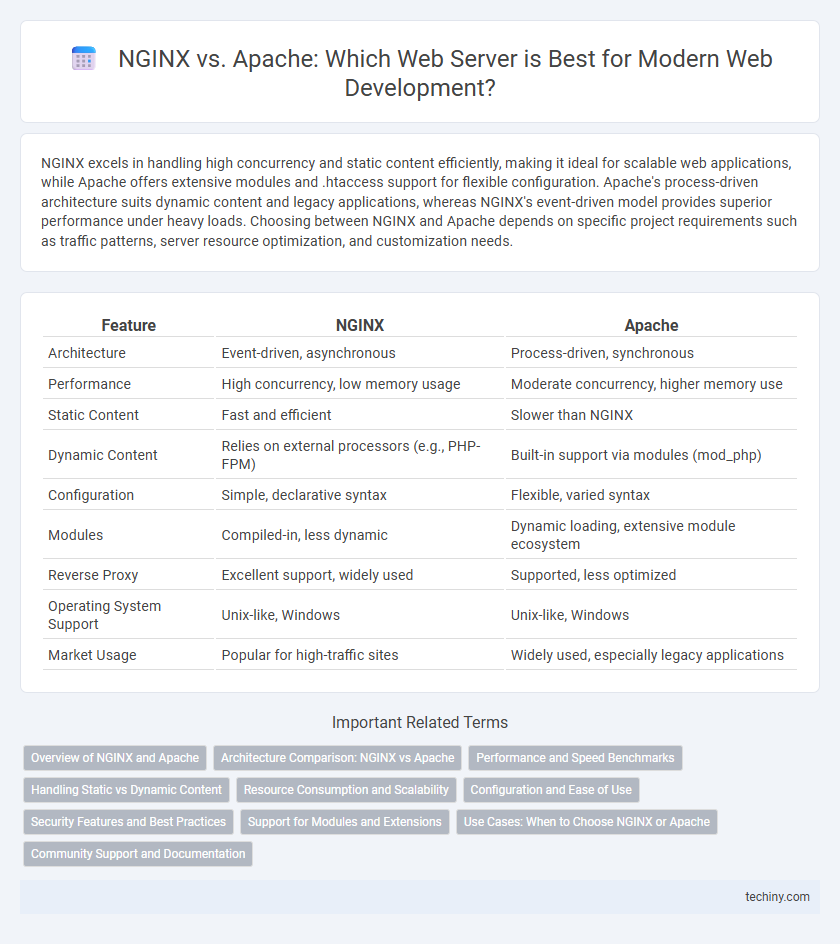NGINX excels in handling high concurrency and static content efficiently, making it ideal for scalable web applications, while Apache offers extensive modules and .htaccess support for flexible configuration. Apache's process-driven architecture suits dynamic content and legacy applications, whereas NGINX's event-driven model provides superior performance under heavy loads. Choosing between NGINX and Apache depends on specific project requirements such as traffic patterns, server resource optimization, and customization needs.
Table of Comparison
| Feature | NGINX | Apache |
|---|---|---|
| Architecture | Event-driven, asynchronous | Process-driven, synchronous |
| Performance | High concurrency, low memory usage | Moderate concurrency, higher memory use |
| Static Content | Fast and efficient | Slower than NGINX |
| Dynamic Content | Relies on external processors (e.g., PHP-FPM) | Built-in support via modules (mod_php) |
| Configuration | Simple, declarative syntax | Flexible, varied syntax |
| Modules | Compiled-in, less dynamic | Dynamic loading, extensive module ecosystem |
| Reverse Proxy | Excellent support, widely used | Supported, less optimized |
| Operating System Support | Unix-like, Windows | Unix-like, Windows |
| Market Usage | Popular for high-traffic sites | Widely used, especially legacy applications |
Overview of NGINX and Apache
NGINX and Apache are two of the most popular web servers used for hosting websites and applications. NGINX excels in handling high concurrency with its event-driven architecture, making it ideal for serving static content and reverse proxying, while Apache offers extensive module support and flexibility with its process-driven model. Both web servers support HTTP/2, SSL/TLS, and load balancing, but their performance and configuration styles cater to different web development needs.
Architecture Comparison: NGINX vs Apache
NGINX employs an event-driven, asynchronous architecture that efficiently handles multiple connections within a single thread, optimizing resource usage and performance under high traffic. Apache utilizes a process-driven or threaded model, creating separate processes or threads for each connection, which can lead to higher memory consumption but offers extensive module support and flexibility. This fundamental architectural difference makes NGINX more suitable for handling static content and reverse proxy tasks, while Apache excels in complex, dynamic content processing with its robust module ecosystem.
Performance and Speed Benchmarks
NGINX consistently outperforms Apache in handling concurrent connections due to its event-driven architecture, resulting in higher throughput and lower latency under heavy loads. Benchmarks show NGINX delivering up to 30% faster response times and better resource utilization compared to Apache's process-driven model. For static content and high-traffic environments, NGINX maintains superior speed and scalability, making it the preferred choice for performance-critical web applications.
Handling Static vs Dynamic Content
NGINX excels at serving static content due to its event-driven, asynchronous architecture, which handles multiple connections efficiently with low resource consumption. Apache is more versatile in processing dynamic content, leveraging its extensive module system and integration with server-side languages like PHP through mod_php. Choosing NGINX or Apache depends on specific web application needs, with NGINX preferable for high-performance static content delivery and Apache favored for complex dynamic content processing.
Resource Consumption and Scalability
NGINX exhibits lower resource consumption by utilizing an event-driven architecture that handles multiple connections efficiently with minimal memory usage, making it ideal for high-traffic websites. Apache relies on a process-driven model, consuming more CPU and memory under heavy loads, which can limit scalability. NGINX's ability to scale horizontally with non-blocking I/O makes it the preferred choice for environments demanding high concurrency and performance.
Configuration and Ease of Use
NGINX uses a straightforward, declarative configuration syntax that emphasizes performance and scalability, making it ideal for handling large numbers of concurrent connections with minimal resource consumption. Apache's configuration is more flexible and modular, supporting .htaccess files for per-directory overrides, which simplifies management for shared hosting environments but can introduce overhead. Both servers offer extensive documentation, yet NGINX requires less frequent reloads for configuration changes, enhancing ease of maintenance in high-traffic scenarios.
Security Features and Best Practices
NGINX offers robust security features including a lightweight event-driven architecture that limits resource consumption, built-in rate limiting, and configurable access controls to mitigate DDoS attacks. Apache, with its extensive module ecosystem, supports powerful security modules like mod_security for web application firewall capabilities and mod_evasive for intrusion prevention. Best practices involve regularly updating server software, using HTTPS with strong TLS configurations, and implementing proper access controls and firewall rules to enhance security on both NGINX and Apache servers.
Support for Modules and Extensions
NGINX supports dynamic modules, allowing flexible loading and unloading without recompilation, whereas Apache offers extensive support for both dynamic and static modules, with a larger variety available due to its longer development history. Apache's module ecosystem enables comprehensive server customization, including robust features for authentication, caching, and URL rewriting, while NGINX excels in lightweight, high-performance modules focused on load balancing and reverse proxying. Developers prioritize Apache for in-depth extensibility and NGINX for efficient handling of concurrent connections through streamlined extensions.
Use Cases: When to Choose NGINX or Apache
NGINX excels in handling high-concurrency environments and is ideal for serving static content, load balancing, and reverse proxying due to its event-driven architecture. Apache is better suited for complex, dynamic content with extensive module support, making it a strong choice for applications requiring .htaccess overrides and legacy support. Choose NGINX for performance-critical, scalable web services, while Apache is preferred for flexible, feature-rich configurations and compatibility.
Community Support and Documentation
NGINX and Apache both boast extensive community support, with Apache's documentation offering comprehensive guides, FAQs, and extensive user-contributed content due to its longer presence in the market. NGINX, while younger, has rapidly expanded its community and provides well-structured official documentation focusing on performance optimization and scalability for modern web applications. Both platforms benefit from active forums, third-party tutorials, and open-source contributions that facilitate troubleshooting and advanced configuration.
NGINX vs Apache Infographic

 techiny.com
techiny.com